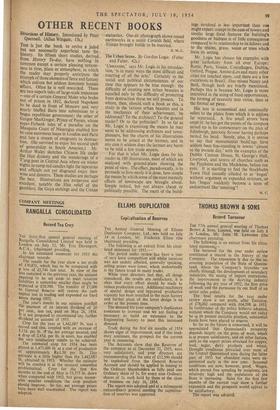URBANISM,' says Mr. Logic in his introduc- tion, 'is in
many ways the most difficult and exacting of all the arts? Certainly in the social and political circumstances of our time this appears to be true enough: the difficulty of creating new urban beauties is equalled only by the difficulty of protecting from destruction those we still possess. To whom, then, should such a book as this, a study in the various urban beauties and in the mechanics of their achievement, be addressed? To the architect? To the general reader? Or to the politician? In so far as Mr. Logic is examining the means he may seem to be addressing architects and town- planners, but the charm of his illustrations seems to be aimed at the layman, and in any case it seldom does the layman any harm to he told a few trade secrets.
For that is what Mr. Logie does for his reader in 180 illustrations, most of which are analysed with ground-plans showing the point of view. The effect, paradoxically, is to persuade us how easily it is done, how simple the means by which some of the most masterly effects of townscapc are brought about. Simple indeed, but not always cheap or politically possible. The merit of the build-
ings involved is less important than one might expect : except in the case of towers and similar large focal features the building's goodness or badness is of little consequence compared to its relationship to its fellows and to the spaces, grass, water or trees which form its setting.
Mr. Logic has chosen his examples with great catholicity from all over Europe: Rome, Paris, Venice, Copenhagen, Dublin, Oxford, Prague, Amstei dam and many other cities are touched upon, and there are a few excursions to Brazil. One misses Nancy and Bath, though both are briefly mentioned. Perhaps this is because Mr. Logie is more interested in the using of fixed opportunities, the turning of necessity into virtue, than in the formal set piece.
His text is economical and continually refers to the plates from which it is seldom far separated. A few small errors 'have crept in: he has got the points of the compass mixed up in his commentary on the plan of Edinburgh, patriotic fervour having perhaps tutra.d his head. Surely, also, it is untrue to say that monumental build:ngs have seldom been free-standing in towns 'almost to the present day,' with the examples of the Dublin Custom House, St. George's Hall,, Liverpool, and scores of churches such as the Pantheon and the Madeleine, before our eyes. It is startling to find the Stockholm Town Hall casually alluded to as bogus' without argument or expanded stricture, or has 'bogus' suddenly become a term of endearment like 'amusing'?


































 Previous page
Previous page